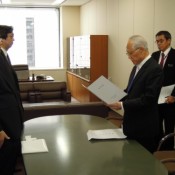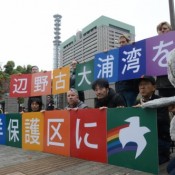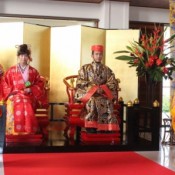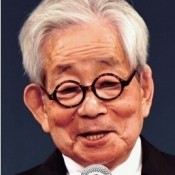Top News
November 27, 2015 Ryukyu Shimpo
Vice-Minister of Defense Kenji Wakamiya talked to Ishigaki mayor Yoshitaka Nakayama on November 26, and formally asked for the go-ahead to deploy units of the Japan Ground Self-Defense Force (JGSDF) to Ishigaki island. In the meeting, Wakamiya said the Japanese government selected Hiraeomata as the candidate area where JGSDF units will be deployed and the government is considering the deployment of 500 to 600 JGSDF members. Nakayama said, “I would like to talk to the city assembly members and citizens and then make a decision. I have accepted the proposition for now.” However, Nakayma did not make clear his own thoughts on whether to accept the JGSDF deployment to the island.
Wakamiya explained the Japanese government would deploy a civil disturbance unit, which initially reacts to emergency situations, as well as units operating land-to-sea missiles and ground-to-air missiles. Wakamiya said, “Deployment of JGSDF units to Ishigaki island will improve deterrents against attacks, allow JGSDF members to swiftly aid disaster victims when disaster strikes, and contribute to securing the safety of local people.” Wakayama explained the reasons for deploying the JGSDF members to Ishigaki as: 1) it is located in the middle of the Sakishima Islands, which make it possible for the JGSDF members to be the initial response to emergency situations; 2) the island has enough acreage for hosting JGSDF units and is equipped with an airport and harbors; and 3) provides infrastructure for hosting the JGSDF members and their families.
Nakayama said, “I understood the importance of the national security, and Self-Defense Forces in the Nansei Islands in terms of national defense and disaster prevention. I would like to decide whether to host the JGSDF units after disclosing the information to the citizens and continuous discussions.” After the meeting, Nakayama talked to the press, saying, “I cannot tell you whether I will support the deployment at the moment.”
(English translation by T&CT)
Go to Japanese

November 30, 2015 Ryukyu Shimpo
On the afternoon of November 29, about 4,500 people gathered in the Hibiya Open-Air Concert Hall in Tokyo’s Chiyoda Ward, demanding that the government of Japan cancel construction of a new U.S. base at Henoko, Nago. The rally was held by civic groups and Okinawan people living in the Tokyo metropolitan area.
This was the largest gathering in Tokyo against the new U.S. base since Governor Takeshi Onaga revoked a landfill approval. Protesters raised their voices against the government of Japan, which has overridden the governor’s revocation and resumed construction work.
The organizers also held protests around the National Diet building in January, May and September to urge the government to cancel the construction of the new base.
The November 29 rally in Tokyo aimed to spread the message of “No Henoko” to people throughout Japan before a court opening session of oral proceedings on December 2 at the Naha branch of Fukuoka High Court.
Hiroshi Ashitomi, co-representative of the Helicopter Base Objection Association, said, “The non-violent movement prevails among Okinawans.” He further hoped that the non-violent movement would be spread all over the country.
Suzuyo Takazato, co-representative of the All-Okinawa Council or Shimagurumi-kaigi, explained that the council’s delegation had visited the United States from November 15 to 21 to resolve the Henoko issue.
Norio Oshiro, co-representative of the council and president of the Rengo Okinawa, stressed the necessity of establishing support organizations for the Henoko struggle, saying, “The Abe administration is trampling on democracy, local autonomy and human rights.”
Nahomi Edamoto, cooking specialist, and Hiroshi Tanaka, co-chair of the Association for Inheriting and Propagating the Murayama Statement and professor emeritus of Hitotsubashi University, criticized the national government for pushing the construction of the base.
Members of Students Emergency Action for Liberal Democracy (SEALDs) and citizen groups to protect the war-renouncing constitution called for abolition of the security bills and working together to block the construction of the new base.
Protesters marched along Ginza Street calling out against construction of the new base after the rally ended.
(English translation by T&CT)
Go to Japanese

November 26, 2015 Ryukyu Shimpo
When the Japanese government’s Ministry of Internal Affairs and Communications compiled their “Report of Nationwide [WWII] War Damages” from 1997 to 2009, the report left out any mention of damage suffered by Okinawa Prefecture. On the morning of November 26, Okinawa Vice Governor Ishou Urasaki visited the ministry and appealed to officials to include damage suffered by Okinawa, including details of the Battle of Okinawa, in the report. He met with Secretariat Councilor Shuji Saiki, who reacted positively, saying he appreciated the importance of the issue and expressing a desire to cooperate and include records on Okinawa.
The statement of appeal was signed by Okinawa Governor Takeshi Onaga and was addressed to Minister of Internal Affairs and Communications Sanae Takaichi.
Research for the report began after Okinawa was returned to Japan in 1972, yet Okinawa was not included in the scope of the study. Okinawa was ultimately left out of Japan’s official national record of war damages.
The statement of appeal points out, “Okinawa was turned into a brutal battlefield where many civilians became embroiled in a vicious land battle. Keeping records of this suffering is highly important and must not be neglected.” The statement further called for records of the war to be passed down to future generations so that memories do not fade now that 70 years have passed since the end of the war.
The fact that damage suffered by Okinawa was left out of the Report of Nationwide War Damages was discovered in August through an investigation conducted by the Okinawa prefectural chapter of the Social Democratic Party.
(English translation by T&CT and Sandi Aritza)
Go to Japanese

November 25, 2015 Ryukyu Shimpo
At the Ministry of Defense on November 25, the international NGO Greenpeace Japan requested environmental protection in Henoko and Oura Bay, and a halt to construction of a relocation facility for U.S. Marine Corp Air Station Futenma. The NGO submitted 28,759 signatures collected from abroad, addressed to Prime Minister Shinzo Abe.
Staff and supporters of Greenpeace Japan showed their opposition to the Henoko relocation project by carrying placards in front of the Ministry of Defense with slogans such as “Save the dugongs,” or “Let’s make Henoko and Oura Bay into ocean sanctuaries.”
During their appeal, the staff of Greenpeace Japan asked the Japanese government about how it is dealing with the issue in which members of the Environmental Oversight Committee (Ministry of Defense) were found to have received donations from companies contracted to do work related to construction of the replacement facility, and about the results of the government’s investigation into the issue. Greenpeace Japan also asked the Ministry of Defense about its cooperation the Ministry of the Environment concerning environmental protection.
A Ministry of Defense official claimed that the Environmental Oversight Committee and its environmental assessments are legitimate by saying “[The donations] are a regular part of cooperative efforts between industry and academic research.” The Ministry further responded to Greenpeace’s inquiry with, “We are communicating back and forth [with the Ministry of the Environment] concerning dugongs.” It failed, however, to give a clear answer in relation to other endangered or scarce species.
Following the appeal Tamara Stark of Greenpeace said she wants to draw attention to the fact that in Oura Bay there is a healthy environment for coral reefs and other varieties of animals aside from dugongs.
Greenpeace Oceans Campaigner Kazue Komatsubara pointed out that the Ministry of Defense’s back-and-forth with the Ministry of the Environment is not adequate, and the legitimacy of the environmental assessments is also questionable.
(English translation by T&CT and Erin Jones)
Go to Japanese

November 17, 2015 Ryukyu Shimpo
A swan goose unexpectedly flew in and landed in Kijoka, Ogimi on November 13. The large swan-like goose is rarely seen in Japan.
Children at Kijoka Elementary School regularly conduct bird-watching activities, which the school has been doing for 27 years, but on November 13 they found an unfamiliar bird in a rice field, known as “Kijoka ta-buku”, near their school.
Kijoka Elementary School children observe wild birds every morning. On this particular morning, Ginji Higa, one of 10 sixth graders who were bird watching, noticed the bird. He checked the bird in a picture book and referred to Toyoko Ichida, an expert on birds, for confirmation.
Higa said, “I wondered what bird it is because it was so big. I am happy to find one.” Kenta Miyagi successfully took a photograph of the bird flapping powerfully. He said, “I am glad to see such a rare bird.”
Ichida, who teaches bird-watching to the children, said, “They are trying to do research on wild birds and understand them. I feel they have grown so much through the activity.”
(English translation by T&CT, Hitomi Shinzato)
Go to Japanese

November 25, 2015 Ryukyu Shimpo
Companies from different industries have developed a Ryukyu dynasty-style wedding in a throne room as a new product for the Okinawa Resort Wedding Association. The firms showed the new product at the Bankoku Shinryokan resort, Nago on November 25.
Okinawan sanshin players and dancers celebrated the mock wedding of a couple dressed in traditional Ryukyuan costumes with a demonstration of a dainty court dance called “yotsutake”.
The companies aim to increase the value added to the resort wedding by holding ceremonies in a gorgeous throne room. There will also be traditional goods, including thrones made of luchu pine, wedding ceremony water glasses made of Ryukyu glass for the bride and groom and a visitors’ book covered with bingata (traditional dyed cloth).
Those involved in the demonstration event wanted to ‘blow a new wind’ into the Okinawa resort wedding business, which relies heavily on images of chapels and beaches. They said the Ryukyu dynasty-style wedding would be a new value-added service using local resources. The Okinawa Resort Wedding Association expects the Ryukyu dynasty-style wedding to become a regular product.
A consortium of four companies, the Sunnet Corporation (Urasoe), Ryukyurian (Ginowan), Urasoe Insatsu (Urasoe) and Sweet-pro (Naha), are promoting the Ryukyu dynasty-style wedding as a project supported by the government. The Okinawa Resort Wedding Association will become the public face in selling the product.
Resort weddings are on the up and Okinawa hosts more than 12,000 couples every year.
(English translation by T&CT)
Go to Japanese
November 25, 2015 Ryukyu Shimpo
On November 24, officials from the Okinawa Prefectural Government (OPG) inspected objects, which appear to be clay pots and stone artifacts, found off the coast of Camp Schwab in Henoko, Nago, the site for the planned relocation of Futenma Air Base. After inspecting the objects, Kamenobu Kinjo of the OPG confirmed their cultural relevance. He said, “I am 90 percent sure the objects were cultural assets.” Kinjo also spoke about the objects’ prospects for formal recognition as cultural assets as well as their care.
At the site where the clay pots and stone artifact were found, an anchor-like stone had already been found and recognized as a cultural asset. If the newly found objects are formally recognized as cultural assets, Nago Education Board is expected to talk to the OPG about recognizing the site as historic ruins. The recognition of the area as historic ruins could possibly delay the construction of the new U.S. military base.
According to Kinjo, nine objects, such as clay pots and ceramics, have so far been recognized as cultural assets. These objects belong to the late Kaizuka period, about 2,000 years ago. Kinjo said the objects that appear to be stone artifacts need to be further inspected for the OPG officials to confirm whether these are cultural assets. The OPG plans to learn further details about the found objects. The head of the Education Board, Akira Moromizato, reported on the same day they would begin working on recognizing the objects as cultural assets.
(English translation by T&CT)
Go to Japanese

November 24, 2015 Ryukyu Shimpo
In the afternoon on November 23, about 740 people gathered at Ryukyu Shimpo Hall in Naha to listen to Nobel Prize in Literature 1994 winner Kenzaburo Oe’s lecture titled “Peace from Okinawa: calling democracy into question.” While holding a dialogue with students, he answered one student’s inquiry regarding the Government of Japan forcing construction of a new U.S. base at Henoko with, “It is an issue that bases with nuclear weaponry are located in a confined place like Okinawa at all. Even if [Futenma Air Station] is relocated, no fundamental problems will be resolved.” His answer drew loud applause from the crowd.
During the lecture Oe reflected on his initial encounter with Okinawa and the Article 9 Association. He also harshly criticized the Abe administration for choosing to refer to April 28th (the day that Okinawa was separated from Japan by the Treaty of San Francisco) as “Restoration of Sovereignty Day,” celebrated at the time of the decision with a cheer of “long live the Emperor.”
“People who risk face danger engaging in activities abroad, especially women, find hope In the fact that the Constitution is part of Japan’s culture,” Oe said, emphasizing that the Constitution of Japan’s worth is rooted in Japanese culture. He added that he wants to teach children to value the Constitution this way.
Following Oe’s lecture, Yoshikazu Shiohira, chief editor of Ryukyu Shimpo, engaged in a dialogue with three attending students. Two junior year students at Okinawa International University and one senior year student at the University of the Ryukyus raised questions and Oe responded. Atsushi Okamoto, president of the publishing company Iwanami Shoten, also took the podium.
Speaking of how base policies ignore Okinawans’ opinions, one student asked, “What is the most important thing for Okinawa?” To this Oe answered, “You all are important. I hope that coming generations speak plainly, ask for specifics, and think ahead. Please do your best.”
In response to another question from the assembly, Oe spoke about his book Okinawa Note. “I still feel nervous that Okinawan people continue to read [my book about Okinawa]. Many people keep coming to debate [these issues], and I have respect for all of you who do.” He closed the session by thanking those gathered for having him come and speak.
(English translation by T&CT and Erin Jones)
Go to Japanese

November 22, Ryukyu Shimpo
Sakae Toiyama reports from Washington, DC
On November 20, delegates from the All Okinawa Council, led by All Okinawa Council co-representative and Kanehide Group chairman Morimasa Goya, visited the Washington, DC headquarters of the AFL-CIO, the largest federation of labor unions in the United States. The delegates asked for cooperation in getting U.S. Marine Corps Air Station Futenma relocated outside of Okinawa. AFL-CIO director of foreign affairs Cathy Feingold expressed her support and her desire to spread the struggle for peace.
A delegation of All Okinawa Council members arrived in the United States on November 15 to convey Okinawan opposition to the planned construction of a new base in Henoko, Nago as part of the planned relocation of Marine Corps Air Station Futenma. November 20 was their last day of scheduled activities.
The AFL-CIO represents 56 member unions and around 12.5 million workers nationwide. It is also a supporter of President Obama.
At the meeting, All Okinawa Council co-representative Goya called for support and cooperation, emphasizing that the U.S. and Japanese governments are forcefully pushing forward with the relocation to Henoko in spite of widespread Okinawan opposition. “In Okinawa, we are facing a crisis of peace and democracy,” Goya stated.
Norio Oshiro, chairman of the Okinawa Trade Union Confederation, stated, “Okinawan labor unions, business leaders, civic organizations, and elected officials are all working together to oppose the Henoko relocation. We hope the AFL-CIO will join our struggle.”
Ms. Feingold explained that the AFL-CIO places great importance on military base issues and the anti-nuclear movement. She also referenced a resolution in solidarity with the Okinawan people in opposition to the new base construction passed on November 15 by the Asian Pacific American Labor Alliance (APALA), an umbrella organization of the AFL-CIO with around 20,000-30,000 members. Ms. Feingold expressed her understanding of the importance of solidarity and her hope to increase widespread participation in the struggle together with APALA.
In addition to meeting with AFL-CIO representatives, the All Okinawa Council delegates also held a demonstration in front of the White House and met with staff representatives of Congress members.
After wrapping up their activities, the delegates held a press conference in Washington, DC. There, co-representative Goya stated that understanding of the Okinawan situation has still not progressed in the United States. He expressed his desire to strengthen action in the United States, including promoting understanding among US congress members.
(English translation by T&CT and Sandi Aritza)
Go to Japanese
November 20, 2015 Ryukyu Shimpo
How on earth does one measure the gravity of a single wish, pursued by many people together? On November 18, the sit-in protest in front of the gate of Camp Schwab, Henoko, Nago, by citizens opposing construction of a new U.S. base reached its 500th consecutive day.
More than 1,000 people took part in the sit-in on this day. Japanese government officials who have not been to the gates of Camp Schwab before do not know how many hours it will take to go to Henoko. Going on a weekday from the prefectural office, Naha, for example, is nearly impossible. One will only make the trip to Camp Schwab if one truly desires to do so. Not only does one need the desire, but the energy and proper circumstances in order to go. There are many people without the necessary means to make their way to Camp Schwab.
Despite the difficulty of transit, people have continued the protest for 500 consecutive days. Citizens have made their intent clear at the polls, and it would be good to see the focus of this intent implemented. Where else in the world can one find local people making such great efforts and large sacrifices for the realization of such simple, modest hopes?
Furthermore, the great efforts made by local residents do not end at the gates to Camp Schwab. The sit-in at the tent near Henoko fishery harbor has continued for 4,232 consecutive days (11 years and 7 months). Even in light of the efforts of local people, the Government of Japan (GOJ) crushes the people’s popular will with strong-arm tactics. There is nothing democratic about that.
The most marvelous part of the efforts citizens make in sparing great amounts of their time is that they remain completely non-violent.
All over the world there are movements of people who cannot help but hold out hope for what they desire, and expend extraordinary amounts of time protesting for the realization of their wishes. In many of these cases, should their resistance be trampled upon, the protesters turn to extreme conduct. Okinawa strikes a high contrast worthy of praise in that its people maintain a completely non-violent demonstration of discontent.
It is in fact the GOJ, rather than Okinawa, that displays violence in this disagreement. One protester was been knocked down and injured in the street, and another had her head submerged underwater. Ambulances have been dispatched multiple times, and on each occasion the people transported have been on the side of the protesters. Also on November 18, one citizen nearly lost consciousness while some members of the coast guard were pinning him down. How is the GOJ so uncivilized?
The GOJ is being backed into a corner. In recent days the GOJ filed a lawsuit to overturn the prefectural governor’s rejection of the landfill permit. Although many say the GOJ’s victory is a foregone conclusion, the method by which the case has been filed is questionable, making the outcome unpredictable. The Okinawa Prefectural Government also plans to file a case. There’s a good chance that the prefectural government will be able to suspend construction in accordance with the Law for the Protection of Cultural Properties. If the governor of Okinawa and mayor of Nago attempt every possible method of halting construction, completion of the project will become nearly impossible.
Most importantly, domestic public opinion is in favor of Okinawa and the international community is watching Japan. The GOJ’s lack of civility appears to stem from impatience. Okinawa has justice on its side.
(English translation by T&CT and Erin Jones)
Go to Japanese

November 12, 2015 Ryukyu Shimpo
Jonathan Dorfan, president of the Okinawa Institute of Science and Technology Graduate University (OIST), along with David Hitlin, Stephen Olsen, and Fumihiko Takasaki, has been awarded the 2016 W.K.H. Panofsky Prize from the American Physical Society. The prize is to honor scientists who have made an outstanding achievement in experimental particle physics.
Dorfan and collaborators conducted two experiments to examine the state of the universe shortly after its birth. The experiments took place at Stanford Linear Accelerator Center (SLAC) and Japan’s High Energy Accelerator Research Organization (KEK) from 1999 to 2010.
These results established the validity of the model of Makoto Kobayashi and Toshihide Masukawa, who went on to receive the 2008 Nobel Prize in Physics.
Dorfan commented that he was delighted to be involved in and contribute to such a wonderful project.
(English translation by T&CT, Hitomi Shinzato)
Go to Japanese








 Webcam(Kokusai Street)
Webcam(Kokusai Street)


